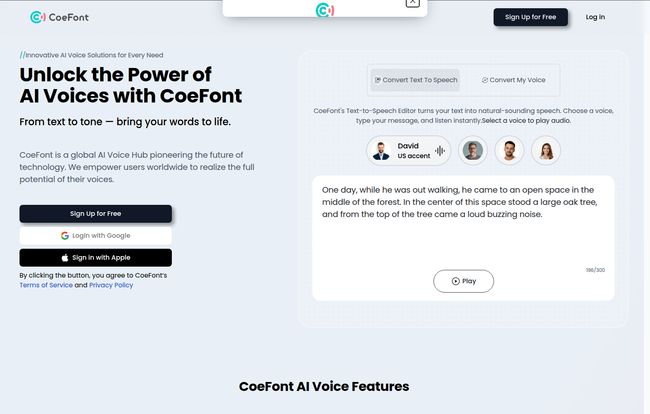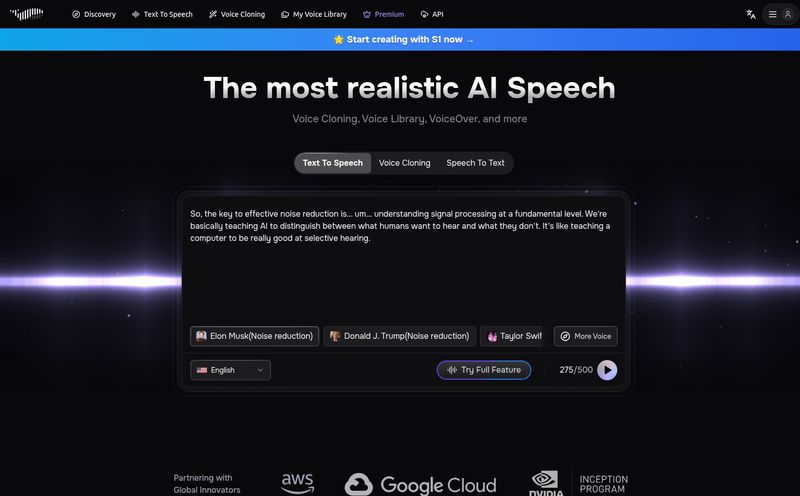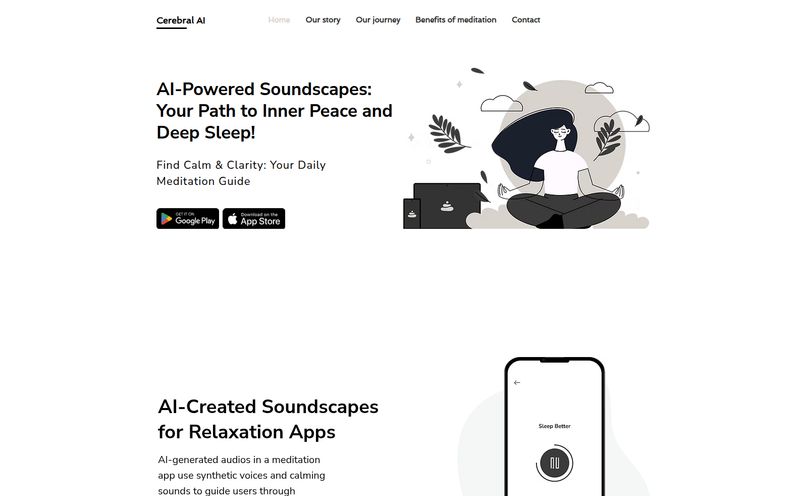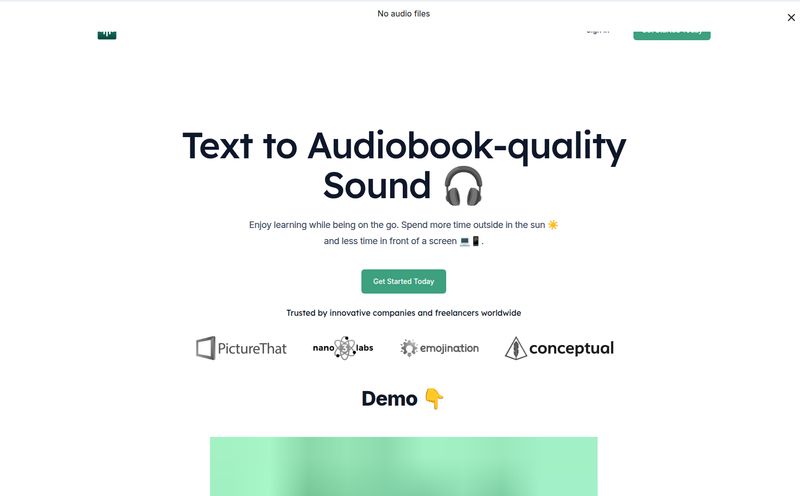For years, text-to-speech (TTS) has been… well, pretty awful. We all have memories of that robotic, monotone voice from early GPS systems or those automated YouTube videos that sounded like a toaster was reading a Wikipedia article. It was functional, sure, but it had all the personality of a concrete wall.
I’ve been in the SEO and content game for a long time, and I've seen countless tools promise “natural-sounding” AI voices. Most of them fall flat. So when I stumbled upon CoeFont, a platform calling itself an “AI Voice Hub,” my professional curiosity was piqued, but my expectations were, shall we say, managed.
But after spending some time with it, I have to say, this one feels different. It’s not just another TTS engine. It’s aiming to be something bigger—a full-blown ecosystem for your digital voice. And for creators, streamers, and even businesses, that’s a pretty exciting prospect.
So, What is CoeFont, Really?
At its core, CoeFont is a platform that uses artificial intelligence to generate and manipulate human voices. But calling it just a “voice generator” is like calling a smartphone just a “phone.” It misses the bigger picture. Think of it more like a digital voice box. You can type in text and have it read aloud in one of thousands of different voices. You can change your own voice in real time. And, most intriguingly, you can create a digital replica of your own voice.

Visit CoeFont
The platform seems built on the idea that our voice is a core part of our identity, and in the digital world, we should have the same control over it as we do in the real one. They're trusted by some surprisingly big names too, like SHARP, SEGA, and Rakuten, which tells me this isn't just some weekend project. It’s a serious piece of tech.
Let's get into what it can actually do.
Diving into the CoeFont Features
CoeFont isn't just a one-trick pony. It’s split into a few key areas that serve different needs, from simple content creation to complex, real-time applications.
The Text-to-Speech Engine
This is the bread and butter. You type, it speaks. The landing page boasts over 10,000 voices, which is a staggering number. In the actual interface, I saw a list of 118 featured voices, ranging from standard narrators to more character-driven anime-style voices. The variety is impressive.
The quality is where CoeFont starts to pull away from the pack. The voices have inflection. They have cadence. They don’t sound perfectly human—there's still a hint of that uncanny valley—but they are miles ahead of the monotone bots of yesteryear. You can adjust the intonation, speed, and pitch, giving you a fine degree of control over the final output. For YouTubers creating faceless videos or businesses needing quick voice-overs for presentations, this is an absolute goldmine.
Creating Your Own AI Voice
Now this is where things get personal. CoeFont allows you to create your own “CoeFont”—a digital clone of your voice. The process is both fascinating and a little bit of a grind. To do it, you need to record yourself reading 50 specific sentences.
Yes, fifty.
It’s not something you’ll knock out in two minutes. This is the price of admission for creating a high-quality voice model. But once you’re done, the platform processes your recordings and creates an AI version of you. You can then type anything, and have it spoken in your own voice. The implications are huge. Imagine automating personalized sales messages, creating endless audio content without ever speaking a new word, or preserving your voice for the future. It’s powerful stuff.
The Voice Hub and Monetization Potential
The Voice Hub is CoeFont's vision for a community marketplace. It's a place where you can share your created AI voice (if you want to, of course) and browse voices created by others. This is where CoeFont shifts from a tool to a platform.
The really juicy part? They're planning to introduce monetization. The idea is that you could allow other people to use your AI voice for their projects and earn a royalty from it. This feature is listed as “coming soon,” so it's not here yet. But for voice actors or people with unique voices, this could be an entirely new revenue stream. It's like licensing out a photograph, but for your vocal identity. I’m genuinely excited to see how this develops.
CoeFont Interpreter for Real-Time Use
This feature is a bit of a showstopper, especially for the streaming community. The CoeFont Interpreter offers real-time voice conversion and translation. Imagine you're a streamer with an international audience. You could speak in English, and the tool could, in real time, output your words in Japanese or another language, all while trying to maintain the characteristics of your own voice. The potential for breaking down language barriers in live content is massive.
Who Is This Actually For?
While anyone could have fun playing with CoeFont, it’s clearly designed with a few key groups in mind.
- Content Creators & YouTubers: This is the most obvious one. Creating voice-overs without having to record every single time is a huge time-saver. You can fix a mistake by just re-typing a word instead of re-recording a whole paragraph. For channels that rely on narration, this could fundamentally change their workflow.
- Streamers: With the real-time voice changer and interpreter, streamers can create more engaging and interactive content. They can adopt different personas on the fly or connect with a global audience in their native language.
- Voice Actors: This might seem counterintuitive, but I see a huge opportunity here. By creating and licensing their own AI voice on the Voice Hub, voice actors could generate passive income. It also allows them to take on more work—lending their voice to an indie game or corporate video via their CoeFont without ever stepping into a studio.
- Businesses and Marketers: From internal training videos to social media ads, the need for quick, affordable voice-overs is constant. CoeFont offers a scalable solution that’s much faster and more flexible than hiring talent for every small project.
"I tried CoeFont, and it was amazing how easy it sounded. The voice creation was a bit difficult, but I was satisfied with the result!"
- A user testimonial from the site
This quote from a user pretty much sums it up. A little effort upfront for a very satisfying, powerful result.
The Good, The Bad, and The AI
No tool is perfect, right? After my hands-on time with CoeFont, here's my honest breakdown. The biggest plus is the sheer accessibility of it all. There's a generous free service available, so you can jump in and start generating audio without pulling out your credit card. The range of voices and the multilingual support are also top-notch, making it a truly global tool. The sound quality, as I've mentioned, is genuinely natural-sounding for an AI, which is the most important hurdle to clear.
On the flip side, the barrier to entry for creating your own voice—that 50-sentence recording session—is a real commitment. It's not a flaw, its a necessity for quality, but it's something potential users should be aware of. Also, the most exciting feature for many, the monetization through the Voice Hub, is still on the horizon. It’s a bit of a tease, promising a future that isn't quite here yet. But I'm an optimist.
What's the Damage? A Look at Pricing
Here’s a funny thing. When I went to find their detailed pricing page to give you a full breakdown… I was met with a classic “Whoops… Pages Not Found!” 404 error. Hey, it happens to the best of us!
What I can tell you is that CoeFont operates on a freemium model. You can sign up and start using many of its core features for free. This is great because it lets you fully test the platform's capabilities to see if it fits your needs. For premium features, more usage, or commercial licenses, you'd typically expect a subscription plan. Since the page is down, I can’t give you exact numbers, but I’d anticipate a tiered structure common with SaaS products—probably a personal plan, a creator plan, and an enterprise solution. For now, the best bet is to sign up for the free account and explore.
Frequently Asked Questions about CoeFont
- Is CoeFont free to use?
- Yes, CoeFont offers free services that allow you to use its text-to-speech features and explore the platform. Advanced features and higher usage limits would likely require a paid plan, though specific pricing details aren't currently available.
- How do I make my own AI voice on CoeFont?
- To create your own AI voice, you need to sign up and follow the voice creation process. This involves recording your voice reading 50 pre-written sentences. The platform then uses these recordings to build your unique AI voice model.
- How realistic do the AI voices sound?
- They sound surprisingly realistic. While you can still tell it's an AI if you listen closely, the voices have natural-sounding intonation and cadence, making them far superior to older, more robotic TTS systems. They are more than suitable for most content creation needs.
- Can I use the voices for commercial projects like YouTube or ads?
- This usually depends on the plan. Typically, free plans are for personal use, while paid or commercial plans grant you the license to use the voices in monetized content. You should always check CoeFont's Terms of Service for the most accurate information on commercial usage rights.
- Who should use CoeFont?
- CoeFont is ideal for content creators, streamers, voice actors, marketers, and businesses who need high-quality, flexible voice solutions. If you create video content, podcasts, presentations, or just want to experiment with AI voice technology, it's worth checking out.
- When can I start making money with my voice on the Voice Hub?
- The monetization feature for the Voice Hub is announced as “coming soon.” There is no official release date yet, but it's a key feature on their roadmap that many users are anticipating.
Final Thoughts: Is CoeFont a Game Changer?
So, is CoeFont the future? I think it’s a massive step in the right direction. It's more than a tool; it's a platform with a vision. The idea of a democratized marketplace for voices, combined with high-quality AI voice creation, is genuinely innovative.
It's not perfect. The voice creation process requires patience, and we're still waiting on some of its most promising features. But the foundation is incredibly solid. For anyone in the digital creation space, CoeFont is, at the very least, a tool you should be aware of. And at its best, it might just become an indispensable part of your creative toolkit. I, for one, will be keeping a very close eye on it. Now if you'll excuse me, I have some content to create with my new AI voice twin.



